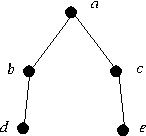For example, in the graph below vertex a has 4 distance-2 neighbors, vertices b and c have 3 distance-2 neighbors each, and vertices d and e have 2 distance-2 neighbors each.

What to submit: A printout of just the function numDistance2Neighbors.

- The order in which vertices in the graph are discovered by depth first traversal. You can show this by simply listing the vertices in the order in which they are discovered.
- The depth first traversal tree.
What to submit: For each of the two depth first traversals, the list of vertices of the graph in the order in which they are visited and a picture of the depth first traversal tree. There is no need to submit any code for this problem.
Using the stack so maliciously tampered by Lord Vader,
perform depth first traversal on the graph
shown in Problem 2, starting first from vertex A
and then starting from vertex B.
Again, for each traversal, show
(i) the order in which vertices are discovered by
depth first traversal and (ii) the depth first traversal tree.
What to submit: For each of the two depth first traversals, the list of vertices of the graph in the order in which they are visited and a picture of the depth first traversal tree. There is no need to submit any code for this problem.
What to submit: A printout of the modified program quickSort1.java with your modifications highlighted.